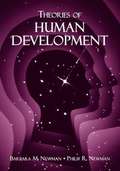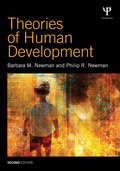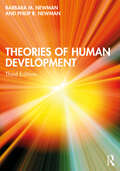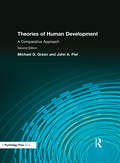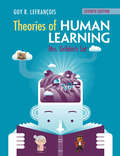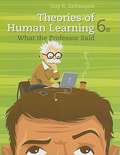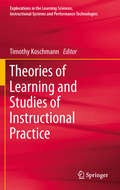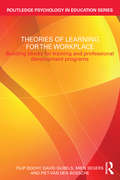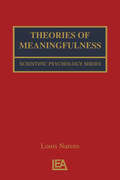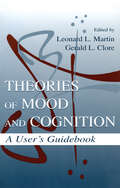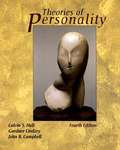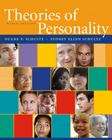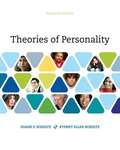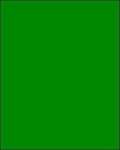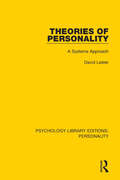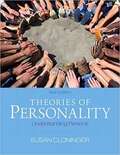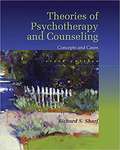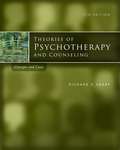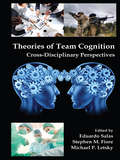- Table View
- List View
Theories of Human Development
by Barbara M. Newman Philip R. NewmanIntended for courses on theories of human development, this new text presents nine theories grouped into three major families - those that emphasize biological systems; those that emphasize environmental factors; and those that emphasize a dynamic interaction between biological and environmental forces. The nine theories selected have a long and productive history in human development and continue to evolve as a result of new insights. The inclusion of social role theory and life course theory expand the book's relevance to the study of adulthood and aging. Grouping the theories by families enhances students' ability to think critically about theoretical ideas, assess the strengths and weaknesses of each theory, and gain a deeper understanding of how each theory guides research and application. The three families are introduced with a brief overview of the unique perspectives of each theory and the rationale for grouping these theories together. Discussion of each theory includes: the historical and cultural context in which the theory was developed; an overview of key concepts and important ideas; new directions in contemporary scientific work; a research example illustrating how the theory has been tested and modified; an application showing how the theory has guided the design of an intervention or program; an analysis of how the theory answers basic questions about human development; and a critique highlighting the theories' strengths and weaknesses. Theories of Human Developmentserves as a text in advanced undergraduate and/or beginning graduate courses in theories of human development. Its clear organization and engaging writing style make it accessible to students with a minimal background in human development.
Theories of Human Development
by Barbara M. Newman Philip R. NewmanKey human development theories that continue to guide research and practice are examined in this engaging text. Ten key theories are grouped into three families - those that emphasize biological systems, environmental factors, and those that reflect an interaction between the two. This organization enhances students' ability to evaluate, compare, and contrast theories both within and across families. Each family is introduced with an overview of their unique perspectives and the rationale for grouping them together. Discussion of each theory includes the cultural/historical context during the theory's development, its key concepts and ideas, extensions of the theory in contemporary work, an example showing a modification of the theory, an application of how the theory is used to inform practice, and an analysis of how the theory answers 6 basic questions that a human development theory should address. Each chapter includes an overview of the strengths and weaknesses of the theories to facilitate comparisons. Theories that have a clear lifespan focus along with cases and examples that address issues across the lifespan are included The second edition features: -A new chapter on bioecological theory that highlights the increased use of this theory in the development of family, school, and community intervention programs. -A new epilogue that examines the same case via each of the ten theories illustrating their similarities and differences and how these ideas cast a unique light on a common situation. -New opening cases that bring theory to life along with narrative that links the case to the chapter's concepts, guiding questions that help students compare theoretical perspectives, critical thinking questions that focus on using the theory to interpret the case and personal life experiences, and recommended resources that extend students' understanding. -More examples from various disciplines that address topics students are likely to encounter as professionals. -A new glossary that defines the boldfaced key terms. -Enhanced website at www.psypress.com/9781848726673 that provides instructors with a test bank, Power points, discussion questions and activities, additional cases with questions, teaching notes for using the book with various types of majors, and a conversion guide outlining changes to the new edition and students with key terms with hot links to their definitions, chapter summaries and outlines, and additional resources for further study. -Updated research and applications highlight the latest scientific developments. Ideal for advanced undergraduate or beginning graduate courses in theories of development, lifespan or child development taught in psychology, human development, family studies, education, and social work.
Theories of Human Development
by Barbara M. Newman Philip R. NewmanThis bestselling textbook provides an engaging introduction to 11 major theories about human development that continue to guide research, intervention, and practice. The theories are grouped into three families: those that emphasize biological systems, those that focus on environmental factors, and those that reflect the interaction between the two. This organization encourages readers to evaluate, compare, and contrast key theoretical ideas both within and across families. Pedagogical features foster critical thinking and an active approach to learning. Each family of theories is introduced with a brief overview of their unique perspectives and the rationale for grouping them together. Discussion of each theory includes the cultural/historical context within which the theory developed, key concepts and ideas, extensions of the theory in new directions, a research example, an illustration of how the theory is applied in contemporary practice, and an analysis of how the theory answers six basic questions that a theory of human development should address. Each chapter begins with a case example and related application. There is expanded visual material throughout to enhance and extend key concepts. The third edition also features: a new chapter, "Social Justice Theory," which addresses definitions of social justice, the development of social justice reasoning, emotional foundations, and behaviors related to activism, with particular focus on societal conditions of privilege and disadvantage that create social inequities and impact developmental outcomes consideration of social justice themes as they emerge across theories an increased focus on how theories account for and characterize individual differences, and the value of diversity for human adaptation a new emphasis on gender and sexual identities across theories greater attention to the role of culture as it is featured within each theory, as a component of the macro environment, and as it is internalized through socialization processes a revised epilogue, focusing on implications for family dynamics and links from theory to practice. By focusing on theories that have had a major impact on development science, this book is ideal for advanced undergraduate and graduate courses in theories of development, lifespan, or child development, taught in the fields of psychology, human development, family studies, education, and social work.
Theories of Human Development: A Comparative Approach
by Michael G. Green John A. PielThe authors have grouped the theories into three classical "families" which differ in their views relative to the prime motives underlying human nature. They show how theories are specific examples of more general points of view called paradigms. The theories chosen to represent the three paradigms (the Endogenous Paradigm, Exogenous Paradigm, and the Constructivist Paradigm) were selected because they met four criteria: importance, as judged by academic and research psychologists fertility, as judged by the amount of research the theory has generated scope, as judged by the variety of phenomena the various theories explain family resemblance, as judged by how well each theory represents its paradigm The authors present the "paradigm case" in the lead chapter for each paradigm. This paradigm case is the "best example" for the paradigm. The authors explain why paradigm cases are important, and give them more detailed treatment than other theories in the same paradigm.
Theories of Human Learning: Mrs Gribbin's Cat
by Guy R. LefrançoisBoth a serious academic text and an intriguing story, this seventh edition reflects a significant update in research, theory, and applications in all areas. It presents a comprehensive view of the historical development of learning theories from behaviorist through to cognitive models. The chapters also cover memory, motivation, social learning, machine learning, and artificial intelligence. The author's highly entertaining style clarifies concepts, emphasizes practical applications, and presents a thought-provoking, narrator-based commentary. The stage is given to Mrs Gribbin and her swashbuckling cat, who both lighten things up and supply much-needed detail. These two help to explore the importance of technology for simulating human cognitive processes and engage with current models of memory. They investigate developments in, and applications of, brain-based research and plunge into models in motivation theory, to name but a few of the adventures they embark upon in this textbook.
Theories of Human Learning: What the Professor Said
by Guy R. LefrancoisBoth a serious academic text and a delightful story, this book offers a clear, readable look at a full range of learning theories from behavioral to cognitive. It also covers memory, motivation, connectionism (neural net models), and social learning and concludes with a comprehensive synthesis. Its most apparent strength is its easily accessible style, but its greatest value lies in the clarity of its concepts and its emphasis on practical applications. THEORIES OF HUMAN LEARNING is narrated by a Professor. But this Professor isn't just anyone. In fact, those familiar with previous editions may conclude that he is related to Kongor and Kro, two extraterrestrials who so successfully guided students through the first two editions---or to the Old Man or, later, the Old Woman who led readers through the next editions. Wise as he is, the Professor does the job even more effectively than his predecessors in this sixth edition of THEORIES OF HUMAN LEARNING: WHAT THE PROFESSOR SAID.
Theories of Hypnosis: Current Models and Perspectives
by Steven J. Lynn Judith W. RhueA survey of current theories of hypnosis along with relevant research.
Theories of Learning and Studies of Instructional Practice
by Timothy KoschmannThis is a book about an attempt to change the way math was taught in a particular classroom. Its title plays on our everyday usage of the terms theory and practice. In education, these terms are conventionally treated oppositionally--we have theories about what we should do and we have what teachers actually do do. In this way, theory stands prior, logically and chronologically, to practice; practice inevitably becoming theory's imperfect realization. We seek in this volume, however, to develop a different stance with regard to the relationship between the two. Taking the details of instructional practice as our principle object of study, we explore what role theories of learning might play in illuminating such practices. The book is about actual practices by which teaching is done and how contemporary theories of learning might help us understand those practices. It seeks to provide a foundation for future practice-based inquiry in education, by addressing the methodological question: How do we go about studying instructional practice in a principled way?
Theories of Learning for the Workplace: Building blocks for training and professional development programs
by Piet Van den Bossche Filip Dochy David Gijbels Mien SegersWorkplace and professional learning, lifelong learning, adult learning, learning in different contexts have become of more and more interest and now dominate all aspects of 21st century life. Learning is no longer about ‘storing and recall’ but ‘development and flow’. Theories of Learning in the Workplace offers fascinating overviews into some of the most important theories of learning and how they are practically applied to organisational or workplace learning. With each chapter co-authored by an academic researcher and an expert in business or industry, this unique book provides practical case studies combined with thorough analysis of theories and models of learning. Key figures in education, psychology and cognitive science present a comprehensive range of conceptual perspectives on learning theory, offering a wealth of new insights to support innovative research directions. Containing overviews of theories from Schön, Argyris, Senge, Engeström, Billet, Ericsson, Kolb, Boud and Mezirow, this book discusses: adult learning; workplace learning; informal learning; reflective practice; experiential learning; deliberate practice; organisational and inter-organisational expansive learning. Combining theory and practice, this book will be essential reading for all trainee and practicing educational psychologists, organisational psychologists, researchers and students in the field of lifelong learning, educational policy makers, students, researchers and teachers in vocational and higher education.
Theories of Meaningfulness (Scientific Psychology Series)
by Louis NarensWritten by one of the masters of the foundation of measurement, Louis Narens' new book thoroughly examines the basis for the measurement-theoretic concept of meaningfulness and presents a new theory about the role of numbers and invariance in science. The book associates with each portion of mathematical science a subject matter that the portion of science is intended to investigate or describe. It considers those quantitative or empirical assertions and relationships that belong to the subject matter to be meaningful (for that portion of science) and those that do not belong to be meaningless. The first two chapters of the Theories of Meaningfulness introduce meaningfulness concepts, their place in the history of science, and some of their traditional applications. The idea that meaningfulness will have different, but interrelated uses is then introduced. To provide formal descriptions of these, the author employs a powerful framework that incorporates pure mathematics, provides for qualitative objects and relations, and addresses the relationships between qualitative objects and pure mathematics. The framework is then applied to produce axiomatic theories of meaningfulness, including generalizations and a new foundation for the famous Erlanger Program of mathematics. The meaningfulness concept is further specialized with the introduction of intrinsicness, which deals with meaningful concepts and relations that are lawful and qualitativeness, which is concerned with qualitative concepts. The concept of empiricalness is then introduced to distinguish it from meaningfulness and qualitativeness. The failure to distinguish empiricalness from meaningfulness and qualitativeness has produced much confusion in the foundations of science literature and has generated many pseudo-controversies. This book suggests that many of these disappear when empiricalness is intersected with the other concepts to produce "meaningful and empirical relations," "empirical laws," and "qualitative and empirical concepts." A primary goal of this book is to show that the new theories of meaningfulness and intrinsicness developed in this book are not only descriptive but are also potent. Asserting that they do more than codify already existing concepts the book: *works out logical relationships between meaningfulness concepts that were previously unrecognized; *clarifies certain well-known and important debates by providing rich languages with new concepts and technical results (theorems) that yield insights into the debated issues and positions taken on them; and *provides new techniques and results in substantive scientific areas of inquiry. This book is about the role of mathematics in science. It will be useful to those concerned with the foundations of science in their respective fields. Various substantive examples from the behavioral sciences are presented.
Theories of Mood and Cognition: A User's Guidebook
by Leonard L. Martin Gerald L. CloreApproaching the topic from a social psychological viewpoint, this book provides a forum for some currently active theorists to provide concise descriptions of their models in a way that addresses four of the most central issues in the field: How does affect influence memory, judgment, information processing, and creativity? Each presentation includes a concise description of the theory's underlying assumptions, an application of these assumptions to the four central issues, and some answers to questions posed by the other theorists. Thus, in one volume, the reader is presented with a single authoritative source for current theories of affect and information processing and is given a chance to "listen in" on a conversation among the theorists in the form of questions and answers related to each theory. Students and researchers alike will benefit from the clarity and brevity of this volume.
Theories of Personality
by Calvin S. Hall Gardner Lindzey John B. CampbellThis is the best book on theories ever published. The fourth edition is theory-oriented and has been reorganized into four parts examing theories of psychodynamics, personality structure, growth and perceived reality, and learning. It also includes new chapters on Eysenck, Bandura, Kelly, and social learning theories.
Theories of Personality
by Lawrence Pervin Daniel Cervone John Oliver"Why should you take a course in personality? Why are some people so taken by the field that they decide to become personality psychologists? A basic attraction of the field is that it addresses the questions "Why are people the way they are? Why am I the way I am?" We are all fascinated by such questions, and personality psychology promises to answer them. Admittedly, this text and the scientific field it reviews may not definitively answer all of your questions. Yet much scientific progress has been made in understanding persons and the differences among them. This book will introduce you to some of the answers that contemporary scientific research can provide, while also introducing you to the best and most influential theoretical frameworks that have been developed for studying people." From Chapter 1
Theories of Personality
by Duane P. Schultz Sydney Ellen SchultzThis undergraduate text gives suppositions about the nature of personality arranged by theorist. After chapters on assessment and research and a survey of theory, the authors (both of the U. of South Florida) examine leading approaches of the last 100 years, including psychoanalysis (Freud), neopsychoanalysis (Jung, Adler, Horney, Fromm, Murray) life-span theorists (Erikson), trait theorists (Allport, Cattall, Eysenck, and others), humanistic theorists (Maslow and Rogers), the cognitive theorist Kelly, the behavioral theorist Skinner and social-learning theorist Bandura. The authors conclude with recent advances and research in limited domains and brief descriptions of genetics, environment and consciousness. Annotation ©2004 Book News, Inc. , Portland, OR (booknews. com)
Theories of Personality
by Duane P. Schultz Sydney Ellen SchultzTHEORIES OF PERSONALITY, 11th Edition, which gives you a clear and cogent introduction to this dynamic field. Updated with new research and findings, this popular text discusses major theorists who represent psychoanalytic, neo psychoanalytic, lifespan, trait, humanistic, cognitive, behavioral, and social-learning approaches, while demonstrating the influence of events in theorists' lives on the development of their theories.
Theories of Personality
by Gregory Feist Tomi-Ann RobertsTheories of Personality provides a comprehensive foundation on the nature of personality theory, as well as its contributions to science. Coverage of each theory encompasses a biographical sketch of each theorist, related research, and applications to real life. Written by three preeminent psychology professors―Jess Feist, Gregory J. Feist, and Tomi-Ann Roberts―this program is engaging and student-friendly. The ninth edition provides new studies and sections on topics such as ego identity, gender studies, mindfulness and self-actualization, and more. The Connect course for this offering includes SmartBook, an adaptive reading and study experience which guides students to master, recall, and apply key concepts while providing automatically-graded assessments.
Theories of Personality
by Richard M. RyckmanThoroughly updated to include the latest research references, Richard Ryckman's "theory by theory" approach to personality carefully guides students through major theories in a way that helps them develop a comprehensive understanding of personality.
Theories of Personality (7th edition)
by Gregory J. Feist Jess FeistThis introductory undergraduate text on personality theory uses clear language and an informal writing style, without oversimplifying the theories' original meanings. Underlying the text is the premise that personality theories are a reflection of the unique cultural background, family experiences, personalities, and professional training of their originators. The book begins with definitions of personality and the nature of theory. Subsequent chapters present twenty-three major theories, with biographical sketches of each theorist, related research, and applications to real life. The usefulness of each theory is evaluated on its ability to generate research, integrate existing empirical knowledge, and suggest practical answers to everyday problems. The theories' contributions to other fields, such as art, psychotherapy, and religion, are also examined. Learning features include chapter overviews, key terms and concepts, and a glossary. B&w photos, some from popular culture, add interest. This updated seventh edition has been reorganized, and there is new material on the Big Five trait theory. Jess Feist is professor emeritus at McNeese State University. Gregory J. Feist teaches psychology at San Jose State University. Annotation ©2009 Book News, Inc. , Portland, OR (booknews. com)
Theories of Personality (Eighth Edition)
by Jess Feist Gregory Feist Tomi-Ann RobertsThe 8th edition of Theories of Personality follows in the tradition of the previous versions, by centering on the premise that personality theories are a reflection of the unique cultural background, family experiences, personalities, and professional training of their originators. The book begins by acquainting students with the meaning of personality and providing them with a solid foundation for understanding the nature of theory, as well as its crucial contributions to science. The chapters that follow present twenty-three major theories: coverage of each theory also encompasses a biographical sketch of each theorist, related research, and applications to real life. Changes in the 8th edition included a new chapter 8 on evolutionary personality theory, focusing on the work of David Buss. The Related Research sections in each chapter have also been updated.
Theories of Personality: A Systems Approach (Psychology Library Editions: Personality)
by David LesterDesigned as a text for both graduate and undergraduate students, this book, originally published in 1995, presents an intrapsychic explanation of human behaviour – concepts based on psychological processes and ‘structures’ within the mind. In this context, a unique treatment of personality theory is introduced. It focuses on Freud, Kelly and Angyal: Freud’s psychoanalytic theory of personality based on desires, Kelly’s personal construct theory for thinking, and Angyal’s holistic concepts of personality. Each theory is given a detailed analysis in separate chapters. Freud’s psychoanalytic theory is cast as a theory of motivation, Kelly’s personal construct theory as a theory of cognition, and then it is noted that there is no comprehensive theory of personality based on emotion. Although Angyal’s holistic theory is rarely described in modern textbooks, Lester includes this because none of the other holistic theorists rival Angyal in their range of hypothetical constructs or descriptive terms. Then, in sections dealing with alternative viewpoints, the author shows how other personality theorists actually endorse and expand upon the ideas expressed by the aforementioned three, albeit with different terminology. Recognizing the diversity of holistic views in theories of personality, several counterpoint chapters are devoted to the holistic ideas. Lester separates these into three major areas: theorists who have focused on the split in the mind between the real and ideal self; recent theorists who explore the possibility that the mind is a ‘multiplicity of selves’; and theorists who, though not having their viewpoints sufficiently articulated in the literature, are still well established in the history of psychology. Other features include a presentation of the material in modern viewpoints, instead of the precise and perhaps outdated style as written by the individual theorists, and boxed highlights in each section, providing students with practical capsule information for easy reading.
Theories of Personality: Understanding Persons
by Susan CloningerEnlivens theories through illustrative biographies, clear explanations, the latest research <p><p> Theories of Personality provides an overview of major classic and current theories of personality, brings theories to life through the interpretation of illustrative biographies, and integrates a clear explanation of theory with the latest research. <p><p> In the sixth edition, the organization has changed to reflect the current changes in the field of personality, focusing more on new theories and leaving behind topics that have faded into the historical past. <p><p> Learning Goals <p> Upon completing this book, readers should be able to: <p>• Have a clear understanding of the theories of personality <p>• Identify the major and current theories of personality <p>• Illustrate a real-life example of major concepts of personality theory <p>• Apply theoretical ideas to understanding particular individuals they may encounter in their professional work and personal lives
Theories of Psychotherapy and Counseling: Concepts and Cases
by Richard S. SharfComprehensive in scope yet succinct in its descriptions and explanations, THEORIES OF PSYCHOTHERAPY AND COUNSELING: CONCEPTS AND CASES, 6th Edition equips readers with a solid understanding of the systematic theories of psychotherapy and counseling. The book delivers a thorough explanation of concepts as well as insightful case summaries and therapist-client dialogues that illustrate techniques and treatment in practice. It demonstrates how theories can be applied to individual therapy or counseling for common psychological disorders-such as depression and generalized anxiety disorders-as well as how to apply them to group therapy.
Theories of Psychotherapy and Counseling: Concepts and Cases (Fifth Edition)
by Richard S. SharfComprehensive in scope yet succinct in its descriptions and explanations, THEORIES OF PSYCHOTHERAPY & COUNSELING: CONCEPTS AND CASES, 5e equips readers with a solid understanding of the systematic theories of psychotherapy and counseling. The text delivers a thorough explanation of concepts as well as insightful case summaries and therapist-client dialogue that illustrate techniques and treatment in practice. It demonstrates how theories can be applied to individual therapy or counseling for common psychological disorders--such as depression and generalized anxiety disorders--as well as how to apply them to group therapy.
Theories of Team Cognition: Cross-Disciplinary Perspectives (Applied Psychology Series)
by Eduardo Salas Stephen M. Fiorea Michael P. LetskyCognitive processes in teams have been a valuable arena for team researchers to explore. Team cognition research advances and informs a variety of disciplines, including cognitive and social sciences, engineering, military science, organizational science, human factors, medicine, and communications. There has been a great deal of progress in the team cognition literature, yet the field is still in its early stages of maturity. There is much more to be gained from the field’s insights and there is a need to unite the diverse array of scholarly ideas that permeate the field. This movement will serve to organize the research and ideas that have surfaced in the field, thereby making them more accessible to different disciplines while at the same time, motivating continued progress in the field. This book aims to be a step in this direction and acts as a forum for leading scholars to share their ideas, theories, models, and conceptions about what matters and where more attention is needed in the field of team cognition.
Theories of Visual Perception
by Ian E. GordonTheories of Visual Perception 3rd Edition provides clear critical accounts of several of the major approaches to the challenge of explaining how we see the world. It explains why approaches to theories of visual perception differ so widely and places each theory into its historical and philosophical context. Coverage ranges from early theories by such influential writers as Helmholtz and the Gestalt School, to more recent work in the field of Artificial Intelligence. This fully revised and expanded edition contains new material on the Minimum Principle in perception, neural networks, and cognitive brain imaging.
